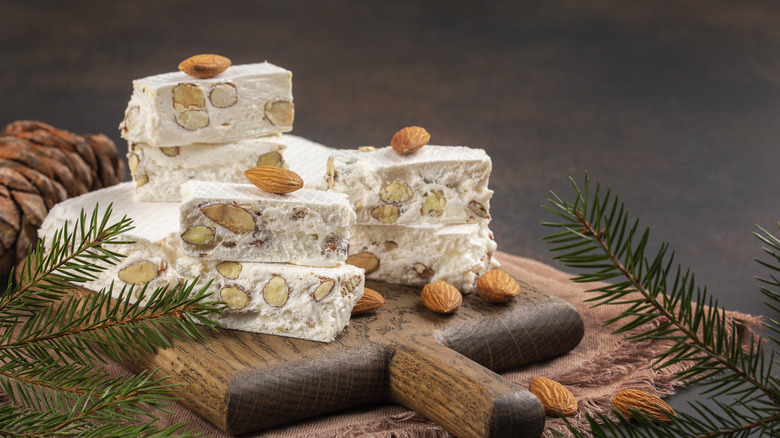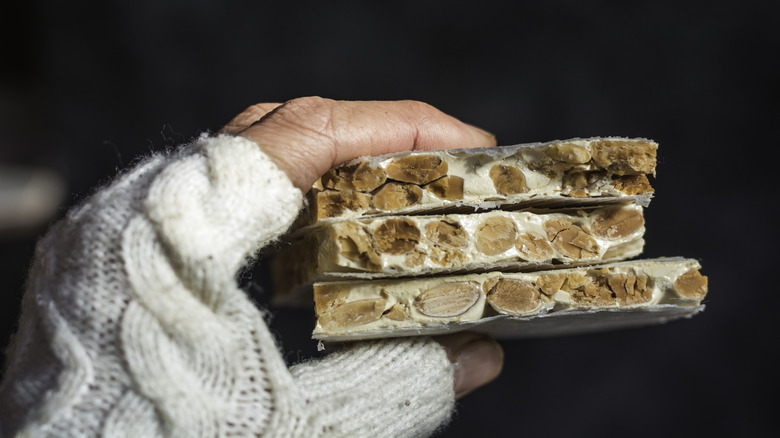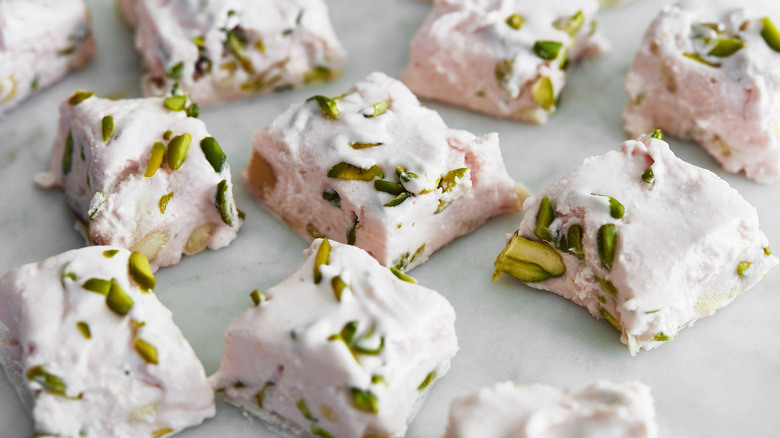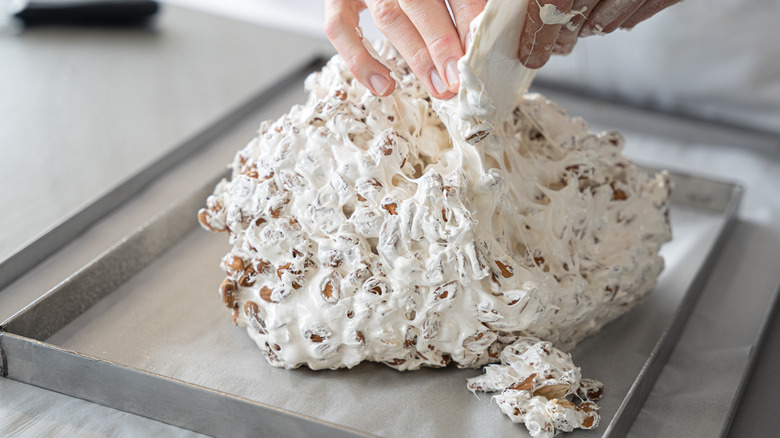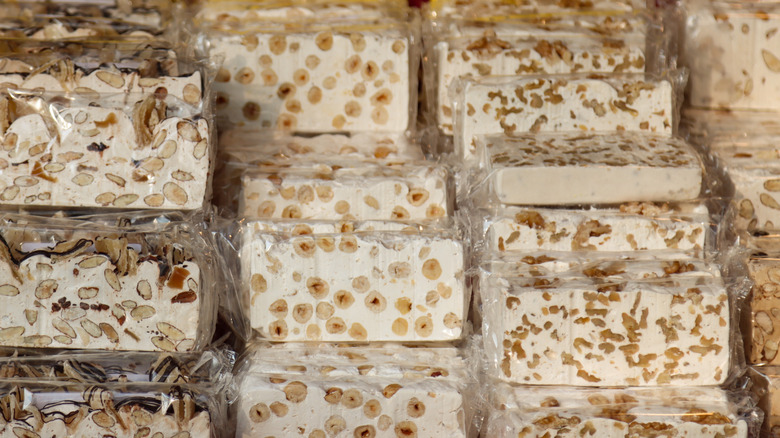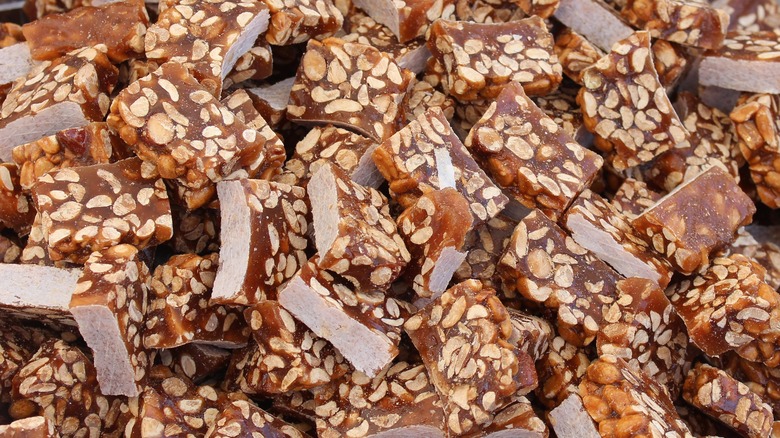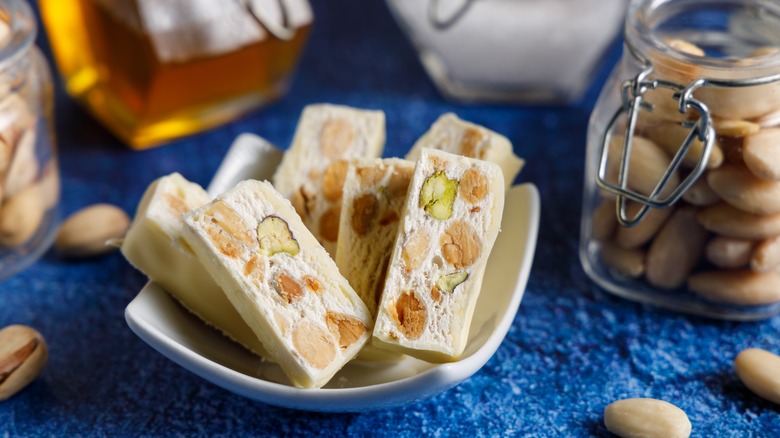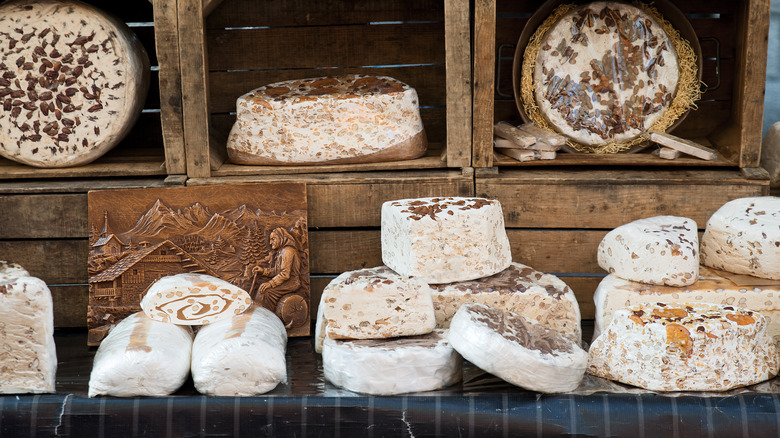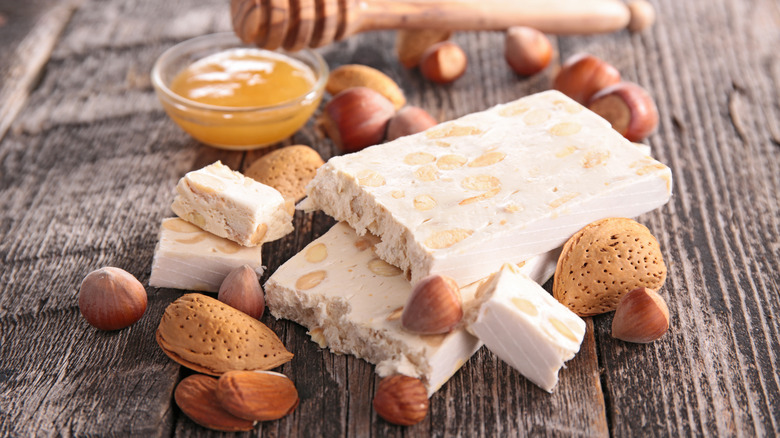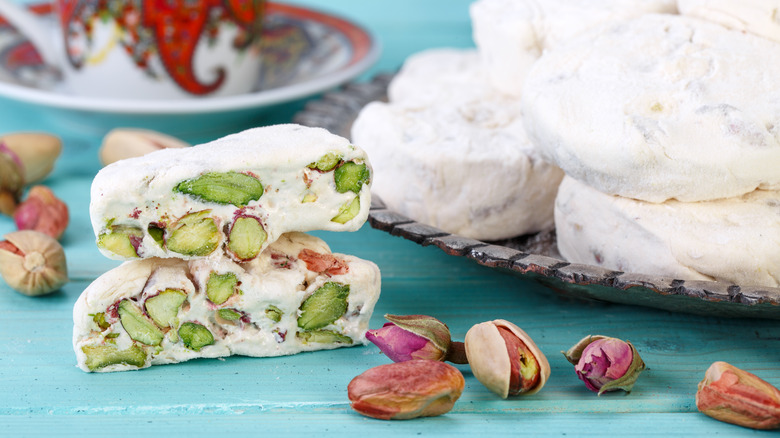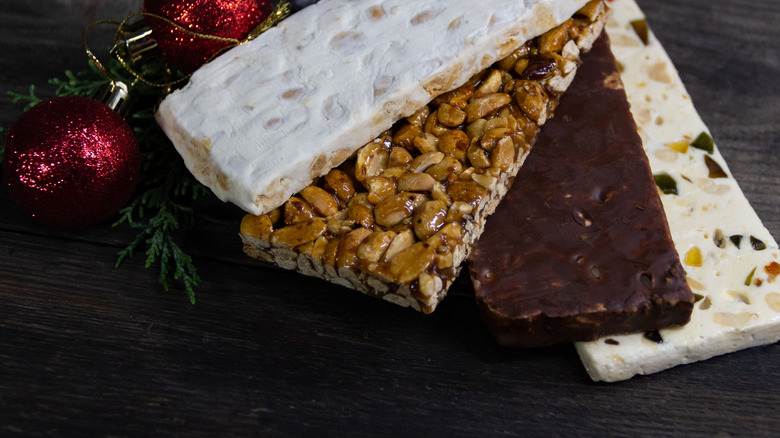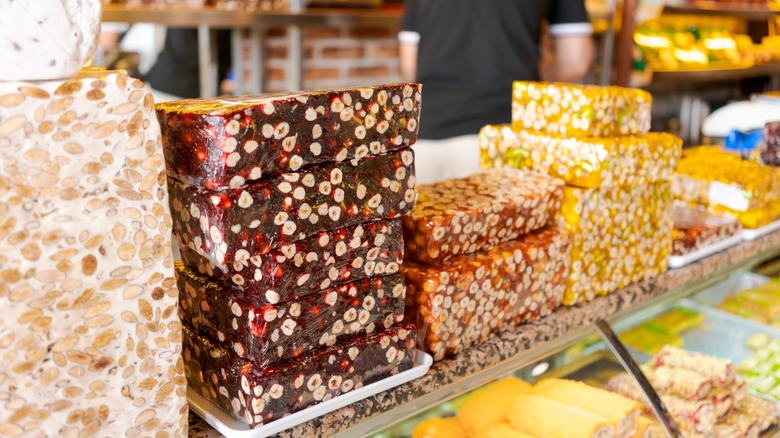Everything You Need To Know About Nougat
If you've visited certain Mediterranean countries, you'll know how important foods like honey, eggs, and nuts such as almonds and pistachios are. When those ingredients were combined in a certain way and dried in the strong Mediterranean sunlight, the result was a sweet, nutty, and luxurious treat called nougat that has been made since Medieval times, and possibly even earlier by the ancient Romans.
Nougat is an important food in certain Mediterranean countries, and it has deep ties to the history and ancient culinary traditions of the regions in which it is made. But don't confuse these artisanal versions with the layer of nougat inside popular candy bars like Snickers and Milky Way. Italian torrone, Spanish turrón, French nougat or nougatine, and Iranian gaz are all decadent and delicious versions of traditional nougat that will make you forget all about Halloween candy.
We've spoken with A.J. Sarno, one of the fourth generation owners of Isgro pastries, a family-run bakery that's been creating handmade Italian treats since 1904 in the Italian market area of South Philadelphia. Sarno is one of the culinary artists around the world who are keeping this ancient tradition alive. He makes Italian torrone, which shares many characteristics with other kinds of nougat, and he helped us understand just what makes this food so special. Read on to learn all about the fascinating history, delightful taste, craftsmanship, and different versions of this beloved and unique dessert that has been continuously enjoyed around the world for centuries.
What is nougat?
Nougat is an aerated confection, which puts it in the same category as marshmallows, sponge cake, and taffy. It can be found in different forms, from artisanal products, to candy bars, to colorful homemade versions filled with candied fruit or nuts and cut into small white squares. Nougat is made with honey, sugar, or, in cheaper versions, with corn syrup and additives. Just like when making a meringue, whipping the egg whites during nougat production incorporates air inside them, which is responsible for the treat's fluffiness. Finally, nougat usually contains nuts or other additions like dried fruit, citrus, or cocoa.
Nougat is sweet and sticky, but the texture can be soft, chewy, or very firm and brittle. Most versions are white, but lesser-known black versions made with cocoa can be found as well. While the ingredients in soft and hard nougat are often the same, the cooking temperature is tweaked to achieve the desired firmness.
We asked A.J. Sarno why, with all the sweets out there, nougat is worth trying. He says that nougat "combines the sweetness and richness of honey with a nutty counterpart, primarily almonds and pistachios. For someone who does not like overly sweet items, it is an excellent option." Nougat like torrone made with traditional processes and ingredients will be sweet and delicious, but it won't be as artificially sweet as commercial candy bars. It's worth trying a traditional piece to taste the difference.
A history of nougat
Nougat is an ancient treat that's at least a thousand years old. Legend has it that the Latin nux gatum, or nut pie, is the origin of the word nougat, and it's true that honey, nuts, and eggs were commonly eaten in ancient Rome. It's speculated that the Romans mixed nuts and honey to make an easily preserved snack for the road. After all, honey never expires, so it has a great shelf life. The first historical mention of nougat is found in Arabic books in Baghdad from the 900s. The mention is of a sweet called natif or native, said to have been invented in the city of Harran, in modern-day Turkey, around the same time.
Nougat was introduced to Spain from the Middle East during the Arabic occupation of the Iberian peninsula from 711 to 1492. It eventually reached Italy in the 1400s and France in the 1600s. In fact, Nostradamus included a recipe for nougat in his 1555 cookbook Traité des fardements et confitures, or Treatise on makeup and jams, and said that it came from Italy.
As nougat was introduced around Europe, each country made its own preferred version using local ingredients. Spain created turrón, Italy torrone (also known as mandorlato after mandorla, the word for almond) and, by the 1700s, France's characteristic nougat de Montélimar was crafted in Montélimar, a town in the southeast of France. Today you can find traditional nougat along with commercially prepared nougat in candy bars and other modern sweets.
How is nougat made?
The technique for making traditional nougat hasn't changed that much through the centuries. The ingredients are simple, so the best results will be achieved with high-quality ingredients and careful attention to technique. Whipping the egg whites is especially important. Once done by hand, the whites are now normally whipped mechanically until doubled in size.
A.J. Sarno explains how Italian torrone is made at his bakery. They start by cooking honey and sugar over a low heat. For soft torrone, they are cooked until the temperature reaches 230 degrees Fahrenheit. Then, powdered sugar is added while the mixture continues to cook. The next step is to fold in whipped egg whites, and, finally, nuts — which, in Sarno's case, are almonds and pistachios. According to Sarno, the ingredients for soft and hard versions of torrone are the same. They're both made with honey, sugar, egg whites, and nuts. "The difference between hard and soft comes in the preparation of the ingredients," Sarno says. "Hard torrone is achieved by cooking the honey and sugar to a higher temperature, whereas soft torrone is cooked to a lower temperature to achieve the soft chewy texture."
After the ingredients are cooked, whipped, and mixed, the nougat mixture is spread out in a pan to set for a few hours before being sliced and packaged. Torrone is sandwiched between two layers of pastry wafers, so line the pan with the first layer before you pour.
What is traditional nougat?
Traditional nougat, while easily found in other parts of the world like Europe, is found in specialty shops in the U.S. Here, it's much easier to find nougat in candy bars as a soft, fluffy, and sweet layer. Think the bottom of a Snickers bar under the peanuts, or the entire interior of a 3 Musketeers.
Traditional nougat is a culturally important food made with simple, high-quality ingredients. Techniques have been passed down over the centuries and haven't changed that much. This nougat offers a pure flavor and a delightful texture, somehow fluffy and dense at the same time. It's consumed as a treat in itself, for example a slice may be enjoyed at the end of a holiday meal.
We've definitely enjoyed our share of mass-produced candy bars, but we have to admit it's not the same experience. For one, this kind of nougat is found as part of another recipe like in a candy bar. The taste is artificially sweet and lacks the purity of flavor or the textural experience of the original. The ingredients are different too. Mass produced candy bars are not all-natural products, and they contain ingredients such as corn syrup, hydrolyzed protein, soy lecithin and preservatives to create the uniform texture of the fluffy nougat layer, keep the price down, and give the product a long shelf life. If you're not sure what you're eating, check the expiration date. Natural traditional nougat will only be good for a few weeks.
The three main kinds of nougat
Nougats like Italian torrone and Persian gaz are white, but there are actually three main type: white, nougat, and Viennese, which is also known as German nougat. Made with egg whites, honey, and sugar, white nougat has a light-colored appearance that is a blank canvas to dot with nuts or dried fruit. It can be soft and fluffy or hard.
Black nougat is a thin, dark, and brittle type of nougat. Because there are no egg whites, it's not fluffy and is much harder than white nougat. With the exception of eggs, it contains similar ingredients to white nougat, but it's made in a different way. Essentially, the sugar is cooked on high until it turns into caramel. The dark color can also come from ground hazelnuts or cocoa powder.
Italy has a dark version of torrone that's made with hazelnuts, some of which are ground and mixed with sugar and some of which are left whole inside the candy. If you try making this at home, remember to roast hazelnuts first to enhance their flavor. Dark nougat is also made in France, and it can contain almonds as well as hazelnuts. Nougatine, a French black nougat, is quite thin and brittle. Despite the name, Viennese, or German, nougat is a different kind of food. It's a soft, fudgy, rich blend of hazelnuts, chocolate, butter, powdered sugar, and salt that can be eaten alone or used to fill chocolate pralines.
How to make nougat at home
"Torrone can be made at home, all you need is a pot and a stove," says A.J. Sarno. While the process itself isn't very complicated, it's important to understand the steps ahead of time and work quickly to make the operation successful. Having a few key pieces of equipment will also help. A candy thermometer will allow you to measure the temperature of the sugar, since it must reach a certain number of degrees as it turns into a syrup. A stand mixer will make it easier to whip the egg whites and beat the sugar syrup into them. This is important, because the egg whites are whipped to double their original size to make nougat fluffy.
After that, nuts and other add-ins are quickly and gently folded in. Greasing the spatula or spoon first will help prevent the mixture from sticking to the spatula, since it's very sticky. Finally, the mixture is poured into a greased or lined pan and left to cool for several hours. Then it can be sliced into the size or shape desired.
Choose the best ingredients you can, especially the honey, the flavor of which can vary vastly according to quality. Nuts can be almonds, hazelnuts, or pistachios (take note of this quick pistachio opening hack) according to your taste, and toasting them first will give them more flavor. Grab some water, sugar, and egg whites, and you'll be set for a basic traditional nougat.
Where to buy nougat
If you're wondering where to find traditional nougat, you're not alone. Of course, if you find yourself in certain European countries in December, nougat will be readily available in candy shops, produce markets, and regular supermarkets. Unfortunately, this bounty of artisanal nougat isn't filling the shelves in the U.S. It's definitely much easier to find candy bars containing mass produced nougat. You can find packages of pre-sliced, individually wrapped, more commercial nougat in American supermarkets around the holidays in certain areas, but for a decadent artisanal product, it's best to go straight to the source.
We asked A.J. Sarno where to find it here. "Nougat, or as it is called in Italian culture, torrone, is a delicacy primarily enjoyed around the holiday season," Sarno says. "Torrone specifically can be found in most Italian bakeries around the holidays and in most specialty food stores. We only make torrone around the holidays as the heat in the warmer months do not allow the torrone to set properly."
Some artisan makers like Sarno ship products nationwide, so ordering from them is an option if you're not local. Besides Italian markets and bakeries, consider visiting a gourmet grocery store or an international grocery store, which can be found in many cities. If there's one in your area, you can visit a Middle Eastern grocery store to look for Persian gaz. Traditional nougat can also be ordered online from abroad. Just keep in mind the shipping costs.
Nougat nutritional information
Enjoying nougat in moderation is sensible, mostly because of its sugar content. It's hard to track down nutritional information since there many varieties and it's often made by local independent makers, many of which are abroad. Ferrara is a brand that makes packaged torrone filled with almonds and flavored with vanilla and citrus that's often seen in supermarkets in the US during the holiday season. Three pieces, or a 36-gram serving, of this product has 168 calories, 7 grams of fat, 3 grams of protein, and 23 grams of sugar.
We hesitate to call a confection based on sugar healthy, but traditional nougat or artisanal nougat (the purer the better) is not a bad choice for a sweet treat because of the high-quality, natural ingredients used. If the product has a short shelf life, you know it's not full of artificial preservatives.
At the same time, you'll receive the benefits from some of the ingredients that are shown to protect health. If you can find an artisanal product made with honey, this form of natural sugar is full of antioxidants and polyphenals, which fight free radicals and reduce inflammation. Honey also has notable antibacterial properties and can help people with diabetes manage their blood sugar. Although they're high in fat and calories, nuts are a great source of fiber and nutrients like selenium, manganese, copper, and magnesium. They're also full of antioxidants and can help lower inflammation, manage weight and type 2 diabetes, and lower cholesterol.
Middle Eastern nougat
The first recorded nougat recipe from 10th century Baghdad contains quite a variety of add-ins. Beside the honey and egg whites, it calls for spices like cloves and cinnamon, dried coconut, almonds, pistachios, and hemp seeds to be mixed in. The recipe is called natif, which means dribble. In many Arabic countries today, the sweet is known as mann al sama. This confection contains different1 flavorings from its European counterparts, including cardamom. If you're not familiar with it, cardamom is one of the spices you should start cooking with. Described as warm, complex, peppery, minty, citrusy, and floral, it has a complex flavor that's clearly hard to pin down in words but is a delicious addition to nougat. Middle Eastern nougat is also notable for including rosewater in the ingredients.
Iranian gaz is a well known Persian variety of nougat. This simple, flavorful sweet has been enjoyed for hundreds of years as part of the rich culinary culture of the region. It comes from the province of Isfahan, and today it's one of the most popular souvenirs that tourists purchase during a visit there. Unlike other kinds of nougat that are made with honey, gaz was first made with the sap of the tamarisk tree, but today it can be made with sugar and liquid glucose. A soft and chewy nougat, gaz contains other ingredients such as almonds, pistachios, egg whites, rose water, and spices like saffron. It's linked to Persian hospitality and is served with tea.
European varieties of nougat
European nougats are closely associated with the Christmas season. The origins of Spanish turrón start with the Moors, whose food traditions influenced the native people during their almost one thousand year occupation of the Iberian peninsula. One recipe that stuck is turrón. The two main types are turrón de Alicante, which is a hard version, and Jijona turrón, which is soft.
France produces white nougat and dark nougatine, with nougat de Montélimar a celebrated variety from Monélimar, a city in the South of France in the Drôme Provençal region. It's made with honey and almonds, which grow abundantly in the region. This treat has been tied to the Christmas menus of the region for hundreds of years, being one of 13 desserts, most of which contain white (symbolizing good) or dark (symbolizing evil) nougat.
Italian torrone, also known as mandorlato, is one of the many Italian recipes known abroad and is the kind A.J. Sarno makes in his bakery. It's a little different because it's poured between two layers of wafer paper. On the taste, Sarno says: "Torrone's base is honey, we use clover honey, so you have the sweet richness of the honey, mixed with the nuttiness of the almonds and pistachos." As far as fillings, he explains that "the base for torrone is generally the same, but any variety of nuts or dried fruits can be added based on ones taste." Fillings can also include vanilla, citrus zest, cinnamon, and chocolate.
How to store nougat
Candy bars containing nougat have a long shelf life, but traditional nougat lacks the preservatives found in those mass-produced sweets. The individual components of traditional nougat are pretty shelf stable. Nuts have a long shelf life when properly stored in the refrigerator, and honey can apparently last for centuries. We're on the fence about whether we would taste it, but 3,000-year-old honey excavated from ancient Egypt was found to be still good.
When those ingredients are combined to make nougat, the shelf life drops. Depending on the ingredients and production methods, some types of vacuum packed commercially produced nougat can have a shelf life of about a year. So if you're lucky, you can find those even outside of the holiday season. Artisanal versions made without preservatives won't last as long. The shelf life drops to about two months for an unopened package, but it depends on what kind it is. Italian torrone tends to be more delicate than some other types. A.J. Sarno says that if stored properly in an airtight container, torrone can last for about a month. That's good to know, but we have our doubts about whether we could hold off that long to finish it.
Once you open the package, however, it's important to enjoy it within a couple of weeks. You can keep nougat at its best by storing it in a cool, dark place. Refrigeration isn't necessary. In fact, it will make soft nougat get too firm.
